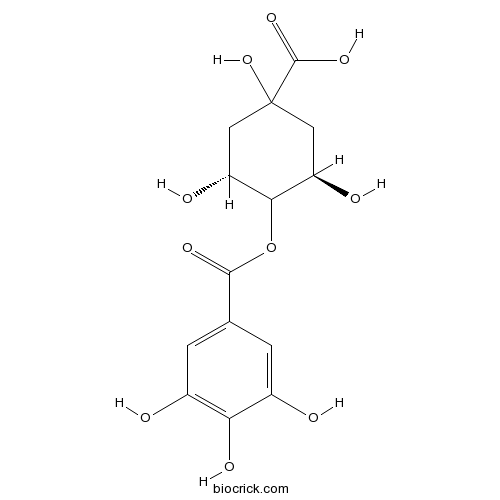4-Galloylquinic acidCAS# 110170-37-1 |

Quality Control & MSDS
3D structure
Package In Stock
Number of papers citing our products

| Cas No. | 110170-37-1 | SDF | Download SDF |
| PubChem ID | 475263 | Appearance | Powder |
| Formula | C14H16O10 | M.Wt | 344.3 |
| Type of Compound | Phenols | Storage | Desiccate at -20°C |
| Solubility | Soluble in Chloroform,Dichloromethane,Ethyl Acetate,DMSO,Acetone,etc. | ||
| Chemical Name | (3R,5R)-1,3,5-trihydroxy-4-(3,4,5-trihydroxybenzoyl)oxycyclohexane-1-carboxylic acid | ||
| SMILES | C1C(C(C(CC1(C(=O)O)O)O)OC(=O)C2=CC(=C(C(=C2)O)O)O)O | ||
| Standard InChIKey | OGYBSNRRBNHPNK-LPSXRXAPSA-N | ||
| General tips | For obtaining a higher solubility , please warm the tube at 37 ℃ and shake it in the ultrasonic bath for a while.Stock solution can be stored below -20℃ for several months. We recommend that you prepare and use the solution on the same day. However, if the test schedule requires, the stock solutions can be prepared in advance, and the stock solution must be sealed and stored below -20℃. In general, the stock solution can be kept for several months. Before use, we recommend that you leave the vial at room temperature for at least an hour before opening it. |
||
| About Packaging | 1. The packaging of the product may be reversed during transportation, cause the high purity compounds to adhere to the neck or cap of the vial.Take the vail out of its packaging and shake gently until the compounds fall to the bottom of the vial. 2. For liquid products, please centrifuge at 500xg to gather the liquid to the bottom of the vial. 3. Try to avoid loss or contamination during the experiment. |
||
| Shipping Condition | Packaging according to customer requirements(5mg, 10mg, 20mg and more). Ship via FedEx, DHL, UPS, EMS or other couriers with RT, or blue ice upon request. | ||
| Description | 1. 4-Galloylquinic acid shows some antioxidative activity. |

4-Galloylquinic acid Dilution Calculator

4-Galloylquinic acid Molarity Calculator
| 1 mg | 5 mg | 10 mg | 20 mg | 25 mg | |
| 1 mM | 2.9044 mL | 14.5222 mL | 29.0444 mL | 58.0889 mL | 72.6111 mL |
| 5 mM | 0.5809 mL | 2.9044 mL | 5.8089 mL | 11.6178 mL | 14.5222 mL |
| 10 mM | 0.2904 mL | 1.4522 mL | 2.9044 mL | 5.8089 mL | 7.2611 mL |
| 50 mM | 0.0581 mL | 0.2904 mL | 0.5809 mL | 1.1618 mL | 1.4522 mL |
| 100 mM | 0.029 mL | 0.1452 mL | 0.2904 mL | 0.5809 mL | 0.7261 mL |
| * Note: If you are in the process of experiment, it's necessary to make the dilution ratios of the samples. The dilution data above is only for reference. Normally, it's can get a better solubility within lower of Concentrations. | |||||

Calcutta University

University of Minnesota

University of Maryland School of Medicine

University of Illinois at Chicago

The Ohio State University

University of Zurich

Harvard University

Colorado State University

Auburn University

Yale University

Worcester Polytechnic Institute

Washington State University

Stanford University

University of Leipzig

Universidade da Beira Interior

The Institute of Cancer Research

Heidelberg University

University of Amsterdam

University of Auckland

TsingHua University

The University of Michigan

Miami University

DRURY University

Jilin University

Fudan University

Wuhan University

Sun Yat-sen University

Universite de Paris

Deemed University

Auckland University

The University of Tokyo

Korea University
- Methyl hesperidin
Catalog No.:BCN6341
CAS No.:11013-97-1
- Indoximod (NLG-8189)
Catalog No.:BCC5584
CAS No.:110117-83-4
- Ascomycin
Catalog No.:BCN8286
CAS No.:11011-38-4
- des-His1-[Glu9]-Glucagon (1-29) amide
Catalog No.:BCC5885
CAS No.:110084-95-2
- Plerixafor (AMD3100)
Catalog No.:BCC1158
CAS No.:110078-46-1
- 12-Epinapelline
Catalog No.:BCN2800
CAS No.:110064-71-6
- 7-Hydroxy-3-(4-hydroxybenzylidene)chroman-4-one
Catalog No.:BCN1624
CAS No.:110064-50-1
- Strophantin K (mixture)
Catalog No.:BCC8256
CAS No.:11005-63-3
- Calpain Inhibitor I, ALLN
Catalog No.:BCC1233
CAS No.:110044-82-1
- Tussilagonone
Catalog No.:BCC8365
CAS No.:110042-38-1
- Taurohyodeoxycholic Acid Sodium Salt
Catalog No.:BCC8363
CAS No.:110026-03-4
- 8-O-Ethylyunaconitine
Catalog No.:BCN6260
CAS No.:110011-77-3
- Ouabain Octahydrate
Catalog No.:BCC5211
CAS No.:11018-89-6
- JZL184
Catalog No.:BCC4790
CAS No.:1101854-58-3
- 1,5,8-Trihydroxy-3-methoxy-2-prenylxanthone
Catalog No.:BCN1623
CAS No.:110187-11-6
- Malonylginsenoside Rb(1)
Catalog No.:BCC9230
CAS No.:88140-34-5
- Cochliophilin A
Catalog No.:BCC8154
CAS No.:110204-45-0
- Ginsenoside Rb2
Catalog No.:BCN1064
CAS No.:11021-13-9
- Ginsenoside Rc
Catalog No.:BCN1072
CAS No.:11021-14-0
- Temocapril HCl
Catalog No.:BCC5016
CAS No.:110221-44-8
- Nothofagin
Catalog No.:BCN3787
CAS No.:11023-94-2
- Digitonin
Catalog No.:BCN3734
CAS No.:11024-24-1
- (-)-beta-Peltatin-5-O-beta-D-glucopyranoside
Catalog No.:BCN3607
CAS No.:11024-59-2
- Ganoderic acid N
Catalog No.:BCN2438
CAS No.:110241-19-5
Profiling and characterization by LC-MSn of the galloylquinic acids of green tea, tara tannin, and tannic acid.[Pubmed:17381119]
J Agric Food Chem. 2007 Apr 18;55(8):2797-807.
Green tea, tara tannin, and tannic acid have been profiled for their contents of galloylquinic acids using LC-MS8. These procedures have provided evidence for the first observation of (i) 1-galloylquinic acid (11), 1,3,5-trigalloylquinic acid (22), 4-(digalloyl)quinic acid (28), 5-(digalloyl)quinic acid (29), and either 3-galloyl-5-(digalloyl)quinic acid (32) or 3-(digalloyl)-5-galloylquinic acid (33) from any source; (ii) 4-galloyl-5-(digalloyl)quinic acid (34), 5-galloyl-4-(digalloyl)quinic acid (35), 3-(digalloyl)-4,5-digalloylquinic acid (41), 4-(digalloyl)-3,5-digalloylquinic acid (40), 5-(digalloyl)-3,4-digalloylquinic acid (39), and 1,3,4-trigalloylquinic acid (21) from tara tannin; and (iii) 3-galloylquinic acid (12) and 4-Galloylquinic acid (14) from green tea. The first mass spectrometric fragmentation data are reported for galloylquinic acids containing between five and eight gallic acid residues. For each of these mass ranges at least two isomers based on the 1,3,4,5-tetragalloylquinic acid core (25) and at least three based on the 3,4,5-trigalloylquinic acid core (24) were observed. Methanolysis of tara tannin yielded methyl gallate, methyl digallate, and methyl trigallate, demonstrating that some of these galloylquinic acids contained at least one side chain of up to four galloyl residues.


